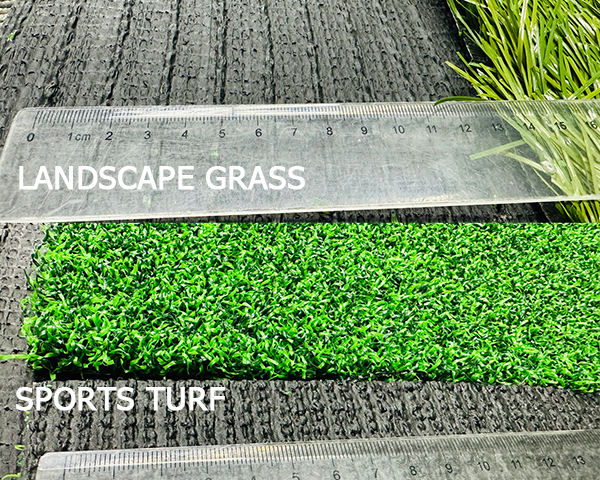
Tufting Gauge in Different Artificial Grass Styles
The tufting gauge is a critical specification in artificial grass manufacturing, referring to the distance between rows of stitches. Measured in inches (e.g., 3/8”, 5/8”), the gauge determines the density, appearance, and performance of the grass. Each type of artificial grass is designed with a specific gauge to suit its intended purpose. Below is a detailed summary of tufting gauges in various artificial grass styles, including woven grass, conventional grass, sports turf, landscape grass, and short-pile grass.
1. Woven Artificial Grass
- Gauge: Ultra-tight gauge (not measured in standard terms like 3/8" due to woven structure; equivalent to 1/10” to 1/8”).
- Description:
Woven artificial grass is manufactured using advanced weaving technology, where fibers are interlaced into the backing instead of tufted in rows.
- Characteristics:
- Fiber distribution is extremely dense and uniform..
- Gives great durability and stability.
- No visible gaps between fibers.
- Applications:
- Sports surfaces requiring uniformity, such as tennis courts and cricket pitches.
- High-traffic commercial areas.
- Gauge: 3/8” to 5/8” (common for residential and commercial use).
- Description:
The most widely used style, conventional artificial grass employs a tufted structure with fibers stitched into a durable backing.
- Characteristics:
- This medium-density surface is well-suited for a variety of applications, offering an ideal balance between affordability and natural aesthetics.
- The 3/8" gauge produces denser grass, while the 5/8" gauge yields lighter grass at a competitive price point.
Applications include residential lawns and gardens, rooftop terraces, and commercial landscapes.
For sports turf,
3. Sports Turf
- the gauge ranges from 5/16" to 3/4", depending on the sport.
- Description:
Sports turf is designed with performance and durability in mind, with varying gauges to meet specific athletic requirements.
- Gauge by Sport:
-The 5/16" to 3/8" option is ideal for sports that require a fast ball roll, such as hockey and tennis.
- 5/8" to 3/4": This option is often used in sports like football, soccer, and rugby, as it can provide enhanced shock absorption and ball behavior.
- Characteristics:
- High durability for heavy use.
- Infill (sand or rubber) often added for stability and cushioning.
- Applications:
- Football and rugby fields.
- Multi-sport complexes and training grounds.
4. Landscape Grass
- Gauge: 3/8” to 5/8”.
- Description:
Landscape grass is designed with aesthetics and decoration in mind, with the aim of replicating the lush, natural look of real grass.
- Characteristics:
- Denser grass at 3/8” gauge gives a soft, full appearance.
It seems that the wider 5/8" gauge could be a more cost-effective solution for larger areas.
- Often combined with varying pile heights and fiber textures for a realistic look.
- Applications:
- Residential gardens and public parks.
- Poolside and leisure areas.
5. Short-Pile Artificial Grass (Commercial Grass)
- Gauge: 3/16” to 5/32”.
- Description:
Short-pile grass, also known as mini grass, features tighter row spacing to ensure a compact and uniform appearance, despite shorter fiber length.
- Characteristics:
- High-density surface with tight stitching.
- Durable and lightweight, suitable for decorative purposes.
- Ideal for small spaces and indoor installations.
- Applications:
- Event decorations, walls, and displays.
- Balconies and small patios.
Comparison Table of Tufting Gauge in Different Grass Styles
| Grass Style | Tufting Gauge | Density | Key Features | Applications |
| Woven Grass | ~1/10” to 1/8” | Very high | Dense, seamless surface with interwoven fibers | Professional sports fields, high-traffic areas |
| Conventional Grass | 3/8” to 5/8” | Medium to high | Affordable, realistic appearance | Lawns, landscapes, rooftops |
| Sports Turf | 5/16” to 3/4” | Sport-specific | Tailored to athletic needs, durable and shock-absorbing | Football, tennis, hockey, multi-sport grounds |
| Landscape Grass | 3/8” to 5/8” | Medium | Realistic look, suitable for aesthetic applications | Gardens, parks, poolside areas |
| Short-Pile Grass | 3/16” to 5/32” | High | Compact, durable, ideal for small-scale decorations | Indoor decor, event displays, balconies |
Factors Affecting Gauge Selection
1. Application Requirements:
- Dense gauges (e.g., 3/8”) are ideal for high-traffic or decorative areas needing a lush appearance.
- Wider gauges (e.g., 5/8”) are more cost-effective for larger installations or less demanding uses.
2. Material Costs:
- Tighter gauge spacing increases material use, making the grass more expensive but also denser and more durable.
3. Aesthetic Preferences:
- Dense turf appears more natural and premium, while wider-spaced rows may look less full.
4. Durability:
- High-density turf with a tighter gauge is better suited for wear-and-tear in sports or heavily trafficked areas.
Conclusion
Understanding the tufting gauge of artificial grass is essential to selecting the right product for your needs. Each style has unique features tailored to specific applications, from the ultra-tight woven structure for professional sports to the cost-efficient wide-gauge landscape grass. Proper selection ensures the best combination of durability, aesthetics, and performance for any project.
![Landscape Grass]()



















